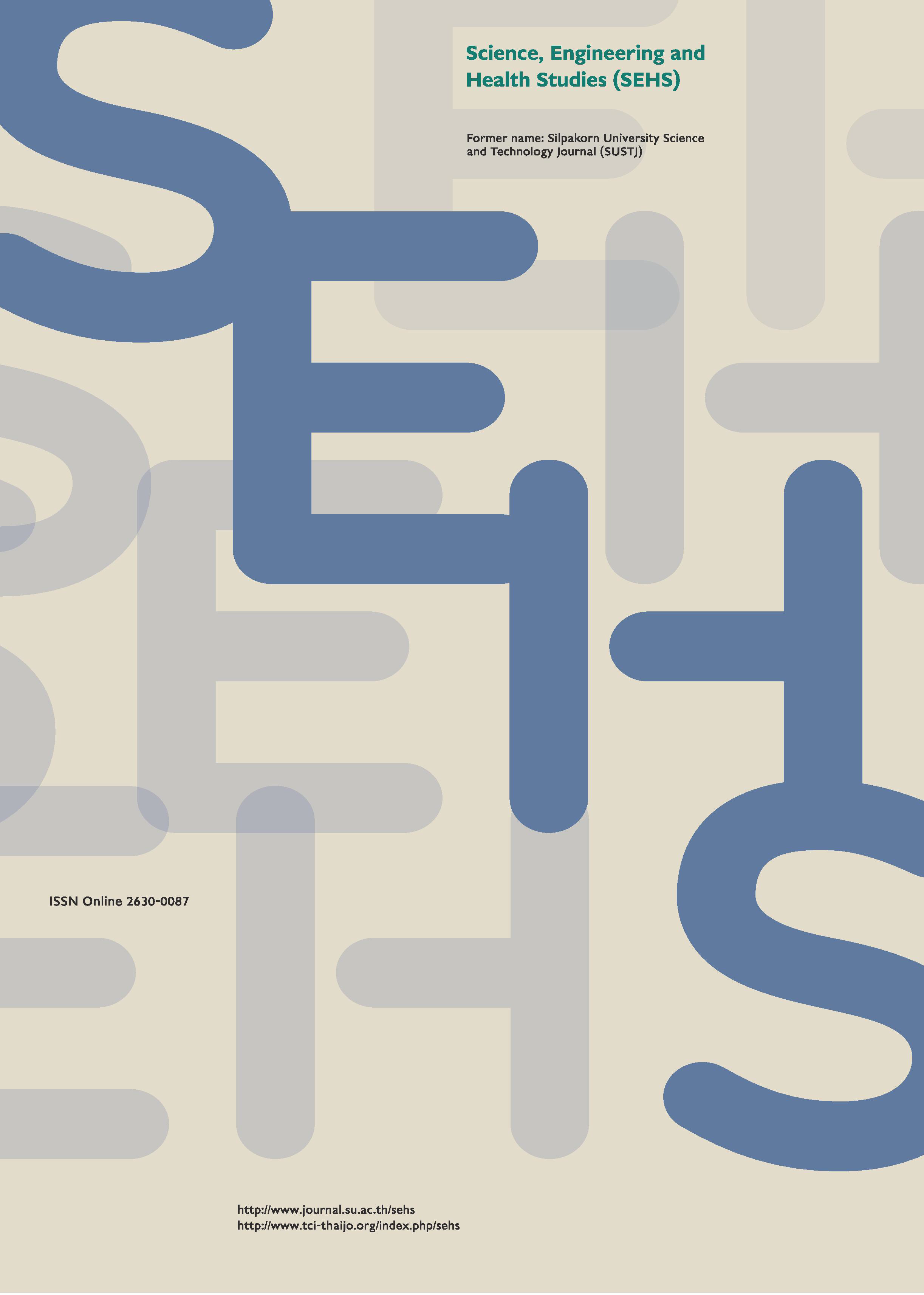Effect of glucomannan and potassium sorbate on quality and shelf life of fresh-cut cantaloupe
Main Article Content
Abstract
The objective of this research was to study the effects of glucomannan, and potassium sorbate on the quality and shelf-life of fresh-cut cantaloupes, which were stored at 6±2°C for 9 days. The concentrations of glucomannan studied were 0.05, 0.10, 0.15 and 0.20% (w/v). Results indicated that the coating solution containing 0.5% (w/v) of calcium chloride and 0.05% (w/v) glucomannan could help maintain weight loss, hardness and firmness, of the samples. However, the increase of glucomannan concentration to 0.10, 0.15, and 0.20% (w/v) showed adverse effects to most quality aspects of the fresh-cut samples. The microbial load of the coated cantaloupe at all concentrations of glucomannan was still high and could extend the shelf life of the samples to 1 day or less. Subsequently, the optimal concentration of potassium sorbate was investigated at 0.05, 0.10, and 0.15% (w/v). Results indicated that the coating solution containing 0.5% (w/v) of calcium chloride and 0.05% (w/v) glucomannan could inhibit the microbial growth, especially bacteria at all concentrations of potassium sorbate studied. Additionally, the coating mixture with potassium sorbate at 0.15% (w/v) could preserve the fresh-cut cantaloupes for a maximum of 5 days with safer microbial loads for commercial use.
Downloads
Article Details
References
Baldwin, E. A., Nisperos, M. O., Chen, X., and Hagenmaier, R. D. (1996). Improving storage life of cut apple and potato with edible coating. Postharvest Biology and Technology, 9(2), 151-163.
Beaulieu, J. C., and Lea, J. M. (2007). Quality changes in cantaloupe during growth, maturation, and in stored fresh-cut cubes prepared from fruit harvested at various maturities. Journal of the American Society for Horticultural Science, 132(5), 720-728.
Benitez, S., Achaerandio, I., Sepulcre, F., and Pujola, M. (2013). Aloe vera based edible coatings improve the quality of minimally processed ‘Hayward’ kiwifruit. Postharvest Biology and Technology, 81, 29-36.
Hongkulsup, C., Uthairatanakij, A., and Borompichaichartkul, C. (2007). Edible film from konjac powder and application on coating ‘Tup tim jun’ java apple (Eugenia jumbos). Journal of Agricultural Science, 38, 208-211.
Khaliq, G., Mohamed, M. T. M., Ali, A., Ding, P., and Ghazali, H. M. (2015). Effect of gum arabic coating combined with calcium chloride on physico-chemical and qualitative properties of mango (Mangifera indica L.) fruit during low temperature storage. Scientia Horticulturae, 190(16), 187-194.
Kittur, F. S., Saroja, N., and Tharanathan, R. (2001). Polysaccharide-based composite coating formulations for shelf-life extension of fresh banana and mango. European Food Research and Technology, 213(4-5), 306-311.
Koh, P. C., Noranizan, M. A., Hanani, Z. A. N., Karim, R., and Rosli, S. Z. (2017). Application of edible coatings and repetitive pulsed light for shelf life extension of fresh-cut cantaloupe (Cucumis melo L. reticulatus cv. Glamour). Postharvest Biology and Technology, 129, 64-78.
Kowalczyk, D., Kordowska-Wiater, M., Zięba, E., and Baraniak, B. (2017). Effect of carboxymethylcellulose/ candelilla wax coating containing potassium sorbate on microbiological and physicochemical attributes of pears. Scientia Horticulturae, 218, 326-333.
Lin, K. W., and Huang, H. Y. (2003). Konjac/gellan gum mixed gels improve the quality of reduced-fat frankfurters. Meat Science, 65(2), 749-755.
Mantilla, N., Castell-Perez, M. E., Gomes, C., and Moreira, R. G. (2013) Multilayered antimicrobial edible coating and its effect on quality and shelf-life of fresh-cut pineapple (Ananas comosus). LWT - Food Science and Technology, 51(1), 37-43.
Department of Medical Sciences (2017). Microbiological quality criteria for food and food contact containers, Announcement No. 3. [Online URL: t.ly/gSuH] accessed on December 7, 2019.
Ngamchuachit, P. (2017). Fresh-cut mango: Physiology and critical factors affecting quality. Journal of Food Technology, Siam University, 12(1), 17-34.
Ponting, J. D., Jackson, R., and Watters, G. (1971). Refrigerated apple slices: Effects of pH, sulfites and calcium on texture. Journal of Food Science, 36(2), 349-350.
Raybaudi-Massilia, R. M., Mosqueda-Melgar, J., and Martín-Belloso, O. (2008). Edible alginate-based coating as carrier of antimicrobials to improve shelf-life and safety of fresh-cut melon. International Journal of Food Microbiology, 121(3), 313-327.
Rojas-Graü, M. A., Soliva-Fortuny, R., and Martín-Belloso, O. (2009). Edible coatings to incorporate active ingredients to fresh-cut fruits. Trends in Food Science & Technology, 20(10), 438-447.
Rojas-Graü, M. A., Tapia, M. S., and Martín-Belloso, O. (2008). Using polysaccharide-based edible coatings to maintain quality of fresh-cut Fuji apples. LWT-Food Science and Technology, 41(1), 139-147.
Saltveit, M. E. (1997). Physical and physiological changes in minimally processed fruits and vegetables. In Proceedings of the Phytochemical Society of Europe, 41, pp. 205-220. Oxford university Press INC, New York.
Sangsuwan, J., Rattanapanone, N., and Rachtanapun, P. (2008). Effect of chitosan/methyl cellulose films on microbial and quality characteristics of fresh-cut cantaloupe and pineapple. Postharvest Biology and Technology, 49(3), 403-410.
Shackel, K. A., Greve, C., Labavitch, J. M., and Ahmadi, H. (1991). Cell turgor changes associated with ripening in tomato pericarp tissue. Plant Physiology, 97(2), 814-816.
Singh, A., Walia, D., and Batra, N. (2018). Fresh-Cut Fruits: Microbial Degradation and Preservation. In Microbial Contamination and Food Degradation, 149-176. Academic Press, USA.
Sopondilok, T., Srilaong, V., Uthairatanakij, A., Wong-Aree, C. and Jitareerat, P. (2010). Effect of glucomanan coating on ripening and quality of papaya cultivar ‘Red Maradol’. Acta Horticulturae, 875, 89-96.
Supapvanich, S., Prathaan, P., and Tepsorn, R. (2012). Browning inhibition in fresh-cut rose apple fruit cv. Taaptimjaan using konjac glucomannan coating incorporated with pineapple fruit extract. Postharvest Biology and Technology, 73, 46-49.
The Association of Official Analytical Chemists. (2000). Official Methods of Analysis, 16th, Washington D. C., USA.
Thomas, W. R. (1997). Konjac gum. In Thickening and gelling agents for food (Imeson, A., ed.), pp. 53-83. London, UK: Blackie Academic & Professional.
Yousuf, B., Qadri, O. S. and Srivastava, A. K. (2018). Recent developments in shelf-life extension of fresh-cut fruits and vegetables by application of different edible coatings: A review. LWT - Food Science and Technology, 89, 198-209.
Zambrano-Zaragoza, M. L., Quintanar-Guerrero, D., Del Real, A., Piñon-Segundo, E., and Zambrano-Zaragoza, J. F. (2017). The release kinetics of β-carotene nanocapsules/xanthan gum coating and quality changes in fresh-cut melon (cantaloupe). Carbohydrate Polymers, 157(10), 1874-1882.


